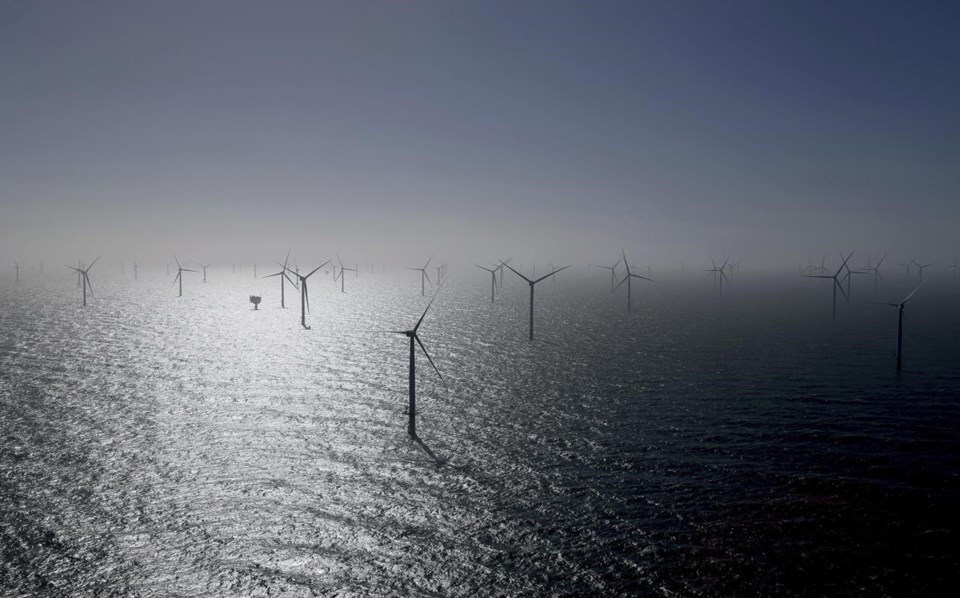HALIFAX — The author of a new report touting Atlantic Canada as a potential offshore wind energy giant says the scaled-down Atlantic Loop electricity grid announced this week is a start but not enough for the region to fully benefit from its production potential.
In the report released this week, Peter Nicholson, who is chair of the Canadian Climate Institute’s board of directors, says a fully realized energy transmission loop linking the Maritimes to Quebec and Newfoundland and Labrador “should be seen as a linchpin component of a national clean energy strategy.”
On Monday, Nova Scotia and New Brunswick committed to plans for a “modified Atlantic Loop” as part of a joint policy statement with the federal government. It would expand an existing connection between the two provinces but not build new lines to Quebec and Newfoundland and Labrador.
The announcement happened to coincide with the release of Nicholson’s report for the Ottawa-based think tank Public Policy Forum titled, Catching the Wind: How Atlantic Canada Can Become an Energy Superpower.
“The announcement does not put the kibosh on the proposal we put forward in our paper,” Nicholson said in an interview. “At best it’s a first down payment. The upgraded inter-tie between Nova Scotia and New Brunswick is something that should be done in any event.”
Both provinces have committed to upgrading their existing power line connection while expanding it west to Point Lepreau, N.B. Nova Scotia Premier Tim Houston has said the option is currently more attractive than the full loop which has tripled in cost to almost $9 billion since 2020, while the modified version is estimated at somewhere between $1 billion and $2 billion.Â
There is still no certainty on exactly how the modified project will be funded, and Houston has said there’s nothing to prevent other parts of the loop from eventually being built.
Nicholson believes an expanded loop will be needed if large-scale offshore wind development eventually takes place in order to export excess power into Quebec, Ontario and the northeastern United States.
“If there isn’t a high capacity transmission option out of Atlantic Canada, the development of offshore wind at real scale wouldn’t happen,” he said.
His report calls for a long-term vision to capitalize on the abundant winds in waters across the Atlantic region, something it says is one of the keys to helping Canada meet its renewable energy goals.
It says the shallow waters near Nova Scotia’s Sable Island alone could accommodate at least 1,000 offshore turbines, each with a 15-megawatt capacity, producing about 70,000 gigawatt hours of clean, renewable electricity each year, enough to power 6.5 million Canadian homes. The output would be almost twice the total electricity currently consumed in Atlantic Canada annually, the report says.
“Offshore wind could be for Atlantic Canada what oil was to Texas or hydro power to Quebec,” wrote Nicholson. “We are talking here not of something incremental, but monumental.”
However, it’s noted that Canada still doesn’t have a single turbine operating or under construction in its offshore waters, while thousands of turbines produce 30 gigawatts of offshore wind power in Europe’s North Sea alone.
Nicholson points out that if Canada is to meet its goal to eliminate greenhouse gas emissions by 2050, it has been estimated by the Canada Energy Regulator that wind power will need to provide about 30 per cent of the total electrical supply. That figure stood at less than six per cent in 2021.
Given the projections, Nicholson said the potential of offshore wind power should be hard to ignore, but "champions" in government or businessare needed to advocate for its development.
“The existence of the potential here (in Atlantic Canada) has not been recognized, and frankly I’m a little mystified as to why that is,” he said. “We’ve known for a long time what the greenhouse gas reduction targets say and what they imply.”
David Neira, energy coordinator with the Halifax-based Ecology Action Centre, said that while “ambitious” in what it advocates, the report is important because it raises awareness about the opportunities that exist with offshore wind.
Neira also noted the need for improved electrical transmission and said he welcomed this week’s announcement out of Ottawa, even though it pares back the full loop concept.
“Maybe there are small steps that we have to do in order to get a project as big as the Atlantic Loop,” he said.
This report by The Canadian Press was first published Oct. 18, 2023.
Keith Doucette, The Canadian Press




